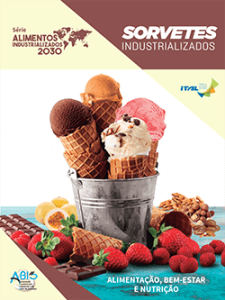NUTRITIONAL VALUE OF INDUSTRIALIZED ICE CREAMS
In addition to the diversity of flavor and textures enjoyed by people, the ice cream consumption seems to generate emotional stimuli that provide a peasant well-being feeling. Man researches have been conducted in an attempt to understand better the psychological and social benefits realized by consumers for determined food, and identified some factors that contribute to the consumption of comfort food: well-being feeling, stress reduction, recovery of socialization memory and past emotions, special occasions, among other.
The calories and nutrients composition for each ice cream varies significantly according to the types of ingredients in its formulation. For example, milky products can be made with different quantities of milk and added with chestnuts and syrups that provide more or less contents of proteins, vitamins, minerals, fibers, probiotics and caloric value. On the other hand,, fruit-based ice cream can vary regarding the types and quantities of vitamins, minerals and fibers, depending on the types of fruit used. In the 180 products, nutrients mandatory statement were identified in the nutritional label: Proteins, Fibers (Dietary fiber), Calories (Energy value, Kcal), Carbohydrates, Saturated fat, Trans fat and Sodium. Among the nutrients voluntarily stated, Vitamins C and Sugar were identified, only the products that state their values in the label. However, there are many other nutrients, probiotic, bioactive compounds(antioxidants, carotenoids and flavonoids), lactoferrins e cytokines, among other natural components of ingredients used in ice creams, which could not be assessed as values were not included in the label.
PROTEINS
The analysis of the sample of 180 products revealed that, in average, ice creams contribute with significant quantities of PROTEINS for the consumers feeding and nutrition. Based on the Anvisa Normative Instruction IN no. 75, from October 8th, 2020, 13 products (7.2% of the sample) can be classified as SOURCE of proteins, per portion of 100 g. The label information do not allow assess whether the proteins have the amino acid profile for the statement of nutritional claims, as established by that normative institution.
DIETARY FIBERS
In average, ice creams do not have significant quantities of FIBERS; however, according to the types ingredients used in their formulation, there are ice creams with relevant content of FIBERS. Based on the Anvisa Normative Instruction IN no. 75, from October 8th, 2020, 13 products (7.2% of the sample) can be classified as SOURCE of FIBERS, per portion of 60 g, and 8 products (4.4% of the sample) as having HIGH CONTENT, per portion of 100 g.
VITAMINS AND MINERALS
In the total of the sample analyzes, a small quantity of ice creams have a voluntary statement of VITAMINS and MINERALS in the nutritional label. Among them, there are 6 products that can be considered as SOURCE and e 3 products as having a HIGH CONTENT of vitamin A, per portion of 60 g, based on the Anvisa Normative Instruction IN no. 75, from October 8th, 2020.
CALORIES (ENERGY VALUE)
Generally, the ice creams ENERGY VALUE vary a lot according to their formulation. There are products with a higher caloric content as they are made from more caloric ingredients, such as açaí pulp with 382 Kcal per ball of 60 g. However, as observed in the chapter on market trends, there are many products with reduced energy value, with reduction of sugar, and fats, and the use of sweeteners. In the sample of 180 ice creams, there are 21 products (11.7% of the sample) with a maximum 100 Kcal per portion of 60 g (equivalent to an ice cream ball).
CARBOHYDRATES
The quantities of CARBOHYDRATES in the ice creams vary significantly according to the ingredients present in their formulation.
However, almost the total of the sample (179 products) does not exceed the quantity of 30 g of CARBOHYDRATES (10.0% of VDR) per 60 g of ice cream.
SUGAR
In the NUTRITIONAL LABEL, the statement of content of SUGAR was identified in 55 ice creams of the total sample (180 products).
The quantity of sugar vary significantly according to the type of ice cream, with lower value observed for a chocolate flavor ice cream and zero-sugar malt (4.8 g/portion of 100 g) and the higher Neapolitan type ice cream for diets with lactose restriction (36.7 g/portion of 100 g). It is observed that, in the ingredients list, sugar war included in 92.2% of the products of the sample.
SATURATED FAT
The quantities of SATURATED FAT in ice creams vary significantly according to the ingredients present in their formulation.
In average, in portions of 60 g, products have 2,9 g of SATURATED FAT (14.4% of VDR); the product with the highest content has 8.4 g (42.0% of VDR) and the product with the lowest content has 0 g (0% of VDR).
In average, in portions of 100 g, products have 4,7 g of SATURATED FAT (23.7% of VDR); the product with the highest content has 14.0 g (70.0% of VDR) and the product with the lowest content has 0 g (0% of VDR).
SODIUM
The quantities of SODIUM in ice creams vary significantly according to the ingredients present in their formulation. According to the Anvisa Normative Instruction IN no. 75, from October 8th, 2020, 176 products (97.8% of the sample) can be considered as LOW SODIUM, and 109 products (60.6% of the sample) can be considered as VERY LOW SODIUM, per portion of 60 g.




